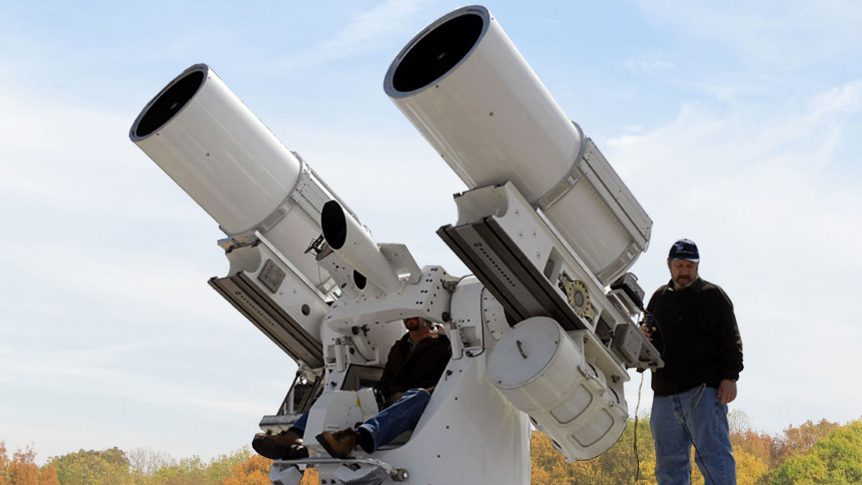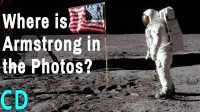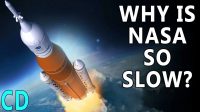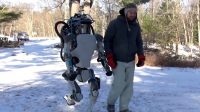These are some of the iconic pieces of launch footage from the space race and the shuttle program, shots taken that would impossible for any human to see up close and personal and many of these were done long before we had miniature high definition cameras and high-speed data links beaming footage live from space. So how did NASA film these incredible shots of Apollo and the Space shuttle?
Now as good as these look from an aesthetic point of view they weren’t done to just wow the public, they had a very important engineering role and that was their primary purpose, to show the engineers and scientists just what was going on at critical stages of the launch and in some cases like the space shuttle Challenger and Columbia disasters, they were key in finding out exactly what happened.
The story of how these techniques were developed goes back to the very first long-range ballistic missile, the V2.
The worlds first CCTV system was developed by Walter Bruch, who would go on to develop the PAL TV format after the war, in order observe the rocket launches from a safe distance in a bunker. At the time there was no way to record the video footage, so cameramen had to stand within the walled test area to film the launches, an extremely dangerous place to be so close to prototype rockets.
Major-General Dr. Walter Dornberger, the V2 project leader recalled of how on one V2 test, the rocket launched but then stalled and hovered about 4 meters above the launch table, something that normally preceded it falling back and exploding. About 100 meters from the rocket and next to the test area earth wall, a cameraman was filming it with a hand-cranked camera. After about 5 seconds the rocket started to rise as it fuel depleted and it became lighter. It gradually rose up, remaining vertical and travelling slowly sideways towards the cameraman who continued filming till it passed almost directly overhead, at which point he then stopped filming and ducked down, the rocket exploded a split second later and crashed about 40 meters beyond the test area wall, a remarkable feat of bravery on behalf of the cameraman.
When the US took the surviving stock of around 100 V2’s to the White Sands Missile Range in New Mexico after the war, they needed a way to observe and record their test flights in greater detail and safety than was done before.
In 1946, Clyde Tombaugh – the astronomer who first discovered Pluto sixteen years earlier – was invited to come to White Sands to help improve the optical instruments tracking the rockets. Tombaugh’s team built their tracking system on a World War II ‘M-45 Quadmount’ Anti-Aircraft platform, affectionately known as ‘Little Bright Eyes’. This was because of the binoculars that the operator used to manually guide the field of view along the flight-path and that was fitted between the five-inch and six-inch refractor telescopes, attached to two 35mm film cameras which replaced the 50 calibre guns.
But it wasn’t only ground cameras that were of importance. In 1946 Clyde Holliday an engineer working on the V2 program, modified a 35mm movie camera to withstand the shock of the launch and impact when it came back to earth.
On Oct 24th 1946, the camera which used Eastman Kodak super XX film running at 4 frames per second, was mounted in an aluminium case with 10mm thick walls into the body of a V2 rocket and launched to a height of 107km. This was the first time that anyone had seen the earth from the edge of space. From here they could clearly see 1,200km in all directions, an area equivalent to 4.1 Million square km and they could clearly see the curvature of the earth.
The M-45 platform was used on three further tracking mounts at White Sands, with some of the ‘T-4’ systems still in use today.
But as America went from testing small ballistic missiles to the mighty Saturn V, a huge array of different cameras became necessary, to check the complex systems during launch. At the John F. Kennedy Space Centre in Florida, the concrete pad at Launch Complex 39A was riddled with fixed high-speed cameras, able to record onto 16mm film at 500 frames per second.
By the time of Apollo 11, there were 201 cameras recording the launch, 119 for engineering and 82 for documentary purposes.
This footage is from Camera E8, which was housed within the concrete pad, out of the line of sight of the engines, and pointed at a heat-resistant mirror made of quartz glass, to avoid being destroyed by at lift-off. Above the pad, similar high frame-rate cameras on the gantries filmed the rocket’s clean separation from the umbilical connections.
As the Saturn V cleared the tower, the ascent was broadcast to a live TV audience worldwide, from a TV camera on a mount descended from Tombaugh’s ‘Bright Eyes’. From the mid-1960s purpose-built tracking mounts were made by companies like Photo-Sonics. Their ‘Cine-Sextant Optical Tracking Mount’ held the twin telescopes on powerful motorised pedestals, allowing heavier optics to track the launch at greater ranges.
This footage from Apollo 4 shows the first stage separation at a height 65km, 211,000 feet and was captured by a camera on the ground. But even with powerful telescopes like this, they couldn’t see the detail of what was happening in the rocket itself.
To see this, cameras were fitted in the Saturn rocket stages to film the stage separations. In fact, the now iconic separation footage seen here which is from cameras mounted in the base of the second stage is often shown as part of Apollo 11 footage but is actually from Apollo 4, these cameras weren’t used on Apollo 11 due to lack of available space.
Apollo 4 was the first full unmanned test of a Saturn V rocket and many things still remained unknown about how it would react during the launch. The engineers wanted to see that the stages separated cleanly and that the interstage structures, the smaller ring like object here didn’t hit the engines during separation as the clearances were very tight.
The J2 engines seen in the top of the frame are firing, although the hot exhaust plume is invisible in the vacuum of space its effect can be seen on the interstage section as it falls away.
On Apollo 6 there were 6 film cameras and 2 TV cameras. The film cameras ran at 100 frames per second and were fitted into pods that were ejected from the stage shortly after separation as you can see here. These would fall back to the earth and once they were in the lower atmosphere they would inflate para-balloons to slow the landing into the sea and allow them to float. There a radio beacon was activated that allowed them to be found in the Atlantic Ocean about 600 miles down range.
Not all the pods were recovered, on Apollo 6 only 2 of the 6 were found and in 1964 on mission SA-7 they ended up being ejected into hurricane Gladys as it made its way across the Atlantic. However seven weeks later two of them were washed up undamaged on the islands of San Salvador and Eleuthera
Whilst some of the cameras filmed the subject directly, others where the first to use fibre optics to remotely place the lenses away from actual cameras to film places that would be otherwise inaccessible, like this, of the inside of the fuel tanks to see how it acted in low gravity and how much it sloshed around during the launch, something that could seriously affect the rocket’s guidance if not controlled.
A decade later, tracking mounts again had to catch up to broadcast the first flight of the American Space Shuttle ‘Columbia’. When the Shuttle launched on 12 April 1981, the stakes were high: to broadcast the launch to a TV audience who were, more than ever before, watching in full colour.
A government contract was awarded to the private company Contraves to deliver a new mobile optical platform, which they called the ‘Kineto-Tracking Mount’ (KTM). Like the Photo-Sonic platform, these retained the recognisable format of the M-45 mount: however, they could be either manned or set up for remote operation within the launch exclusion zone. Although the new robotic mounts were greeted with suspicion by the camera operators at Kennedy Space Centre, ten mobile KTMs were positioned around the launch centre. Short-range optics on these mounts filmed from T-10 to T+57 seconds, with longer-range optics capturing until T+165 seconds.
This piece here of the shuttle discovery at T+40 seconds is shot from a medium distance camera about 3.8km from the launch pad using a 150-inch lens with a 4000mm focal length as the shuttle is accelerating through 20,000 ft. As discovery goes through 145,000 ft at about 120 seconds into the flight the boosters separate which is captured here by another 150 inch, 4000mm focal length lens on a KTM. The weight of the lens alone is about 115kg and the tracking to keep Discovery in the frame was done by a human not an automated system.
After three minutes, the job of filming the ascent transferred to the largest telescope on site: the permanently-mounted 24-inch aperture ‘Recording Optical Tracking Instrument’ (ROTI). With a focal length of up to 12,700mm, ROTI had enough magnification to follow the launch for up to five minutes after lift-off.
ROTI used both radar-assisted tracking and a joystick for manual adjustment, which had such fine sensitivity that it could register a heartbeat if held too firmly.[1]10
During the early shuttle launches over 130 cameras were used to record all aspects of the launch combining 16mm, 35mm and 70mm film formats as well as high definition video. Film was used even after the advent of video because of it’s high resolution and much wider dynamic range, that’s the ability to keep very bright and normally light objects in the same image without them washing out. The video was used for quick access to footage whilst the film was being processed.
The High-speed film Cameras were placed in explosion proof boxes close to the launch pad to record different aspects of the lift-off.
Here is camera E19, it is running at 400 frames per second with a 10mm wide angle lens and recording the engine start-up and flame pattern. The cameras were fitted with automatic exposure control to allow them to film the exhaust plume that from the solid rocket boosters looks as bright as the sun. You can see how wide the dynamic range this gives and how well it works when combined with the film, as in this shot you have the super bright SRB exhaust with the blue sky behind it.
This shot is recording the operation of the explosive hold down bolts, four of which held each of the SRBs to the mobile launch pad till the point of lift-off.
Another great shot is that of the tail service mount disconnect from camera E18. There were one of these on each side of the shuttle, one for the liquid hydrogen and one for the liquid oxygen. Again, a 16mm camera with a 10mm lens is used, as were most the engineering documentation cameras on the mobile launch pad.
What is not easily apparent from the shot is the size of the connector, each one was 1.2 meters wide by 1.8 meters high, that’s bigger than most house doors. They were pulled in with the force of 9,000kg before the protective blast doors dropped down. One of the biggest challenges was that once the door was shut it was pitch black inside, so they had to be light by tungsten lamps but the vibration was so strong that it would blow the filaments in the lamps, so on the latest missions LED lighting is now used.
Cameras were vital to the investigation of the challenger and Columbia disasters.
As the Space Shuttle Challenger rose into the sky on the icy morning of January 28th, 1986, the high-frame-rate cameras on the launch tower filmed a puff of grey smoke escaping from the side of the right Solid Rocket Booster but by the time the pictures were examined, it was too late.
Seventeen percent of all Americans were watching, including millions of school-children, as Challenger broke up 73 seconds after launch. Broadcast live, the footage of STS-51-L remains among the most unforgettable and tragic of the Space Program.
During the investigation into the disaster, footage from NASA’s tracking cameras was essential to identify the sequence of events during Challenger’s last flight. With ROTI’s high magnification, the burst of super-heated gas from the SRB can be seen, and during the explosion, individual elements of the orbiter can be identified: including the crew cabin, which was designed to survive much greater pressures than the fuselage, and was only destroyed on impact with the ocean’s surface below.
Such tragic accidents led to wider use of cameras for each launch, with the number of KTMs increasing to 14 following the Columbia shuttle disaster in 2003.
With the “return to flight” in 2005, STS 114 had over 400 cameras monitoring the launch. On this launch, RocketCam would be used for the second time. This is a camera system fitted to the outside of the SRBs and the main fuel tank. Each Rocketcam has its own transmitter to relay the signal back to launch control. At about 127 seconds into the flight a large piece of debris about 92cm by 27cm was caught by Rocketcam falling from the main fuel tank but luckily not hitting anything. 20 seconds later another smaller piece hit the right wing but after checking with Orbiter Boom Sensor System it was found not to have caused any damage.
Rocketcam is now used on most launches and is responsible for the amazing external footage of the things like booster separations and the landing of SpaceX reusable rockets.
The ‘Return to Flight’ also used high-definition cameras aboard ‘B-57 Canberra’ aircraft, at an altitude of 60,000 feet (more than 18 kilometres). The WB-57 Ascent Video Experiment was able to film the Shuttle even in overcast weather, tracking the launch over a 643-kilometre path into space.
Now, Despite the huge effort and expense devoted to developing optical tracking technology, today even enthusiastic amateurs can film a rocket launch. High-resolution digital cameras and computerised tracking mounts have become affordable and small enough to fit in a backpack. These can be programmed to follow a high-contrast target through the viewfinder.
At Vandenberg Air Force Base in California, a line of these cameras are set up by amateurs several times a month, protected from the rocket’s blast inside PVC piping or hardware store buckets and Armed with audio triggers and consumer battery banks, their innovation is in the tradition of Clyde Tombaugh’s team and ‘Little Bright Eyes’: cobbled together from spare parts, they make a record of human ingenuity, for the next generation.
So What’s your favourite piece of launch footage, let me know in the comments below and maybe your one of the amateur rocket observers or one of the workers at the Kennedy space centre, it would be great to hear your views in the comments.
This was another video which voted for by the curious droid Patreon group which I would like to thank for their ongoing support, you can find out more about that on the link now showing.
So thank for watching and please subscribe, thumbs up and share.






Comments
Thank you so much for making and publishing these. The quality and amount of detail is beautifully released to and in a way that the information is accessible to anyone with a keen interest. In addition, you produce videos and articles through new and interesting questions, raising our curiosity, and the thirst to push the boundaries of knowledge even further.
In particular, I enjoyed the way you manage the topics in a calm, nonjudgmental manner, quite unlike many other discussions one comes across online.
Thank you thank you thank you
I hoped to come back and show someone else this video. Apparently it’s been taken down by copyright claim. Is it the whole video or just a portion? Is modified edit ever likely to be reposted?
Its just one small portion at the end. I’m trying to get hold of the person that put the copyright claim in to sort it out but if that fails I’ll edit that section out and re-upload it.
My favorite shuttle shot is showing the launch effect called the “twang” where the shuttle engines are spooling up to launch power and cause the whole stack to bend. Once the stack returns to vertical the SRBs fire and the Shuttle is off. Most cool.
I was at Playalinda Seashore last month and saw one of the domes that housed one of the camera systems you described. There was also a “field mill” instrument used to measure electric fields ie: lightning.
Excellent production Paul! Thanks very much! You’re gaining a new fan! Me!
Great job Paul, this is the most thorough video I have ever seen on the subject, and belongs with other historic documents about the Apollo era. Our company carries on the legacy by providing these services to the private space sector. In fact, some of those long-range optical tracking mounts in your video have been updated by us with new optics and electronics and are still supporting current missions. Our oxidizer and fuel tank cameras use similar optical separation of lens and camera mostly because the current HD cameras will fail when placed too close to cryo propellants. Keep up the great work and let us know if we can support you in any way!
Wonderful video. It mentions there were millions of children watching when the Space Shuttle Challenger exploded. The reason they were watching was that Christa McAuliffe was to be the first teacher in space.